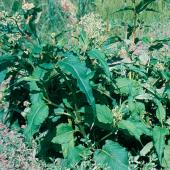Rhubarb, wild
Gwichya Gwich'in Name:
ts'ii gyų̀ų’
Teetł’it Gwich’in Name::
ts'ii gyùu’
Latin Name:
Polygonum alaskanum
Categories:
As food
The picking time for this plant lasts only about two weeks. The rhubarb plant is ready to eat in mid-June when it is about 20 to 25 centimeters tall (eight to 10 inches). When the plant is young it can be eaten raw, after first removing the leaves and seedy tops from the plant, and peeling off the outer skin. It is very crunchy and juicy. Once the plant has gone to seed or has many white flowers, the plant is too dry to eat.
Source: Andre, Alestine and Alan Fehr, Gwich'in Ethnobotany, 2nd ed. (2002)
Wild Rhubarb PuddingTo cook the wild rhubarb into a pudding, cut the whole plant including the tops into small pieces and put into a pot of water. Bring this to a slow boil. Whitefish or cony fish pipes (part of the stomach) and eggs can then be mixed in. On the side, mix together a paste of flour and water to make a thick gravy, and add to the rhubarb. Add sugar to sweeten the pudding to the desired level. Extra pieces of raw rhubarb can be stored frozen in plastic bags for later use.
As medicine
Wild rhubarb is best harvested in late June to early July. The leaves of the wild rhubarb, like fireweed or willow leaves, are used on burns. The leaves can also be dried and stored for later use.
Source: Andre, Alestine, Nan t'aih nakwits'inahtsìh (The Land Gives Us Strength) (2006)




